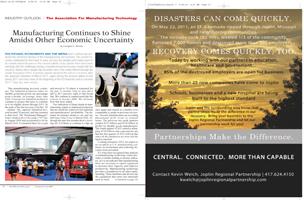
 Politicians, economists and the media have continuously predicted the imminent demise of the manufacturing-led recovery. The current recovery celebrated its third year in June, yet very few people even today seem to be ecstatic about the pace or the current outlook. Every quarter there have been warnings that the challenges facing a manufacturing-led recovery would sink the recovery. Stories that a double-dip recession was in the works filtered through the media throughout 2010. Economic experts declared the end of a recovery after the Japanese disasters of March 2011, again during the oil price spikes in late spring 2011 and once more at the beginning of the EU financial crisis in summer 2011. They, too, were wrong.
Politicians, economists and the media have continuously predicted the imminent demise of the manufacturing-led recovery. The current recovery celebrated its third year in June, yet very few people even today seem to be ecstatic about the pace or the current outlook. Every quarter there have been warnings that the challenges facing a manufacturing-led recovery would sink the recovery. Stories that a double-dip recession was in the works filtered through the media throughout 2010. Economic experts declared the end of a recovery after the Japanese disasters of March 2011, again during the oil price spikes in late spring 2011 and once more at the beginning of the EU financial crisis in summer 2011. They, too, were wrong.
This manufacturing recovery continues. The industrial production index for durable goods has grown one percentage point a month, on average, since June 2009. Forecasts for industrial production continue to project that pace to continue or to be slightly slower through 2013. At the peak of the last recovery (October ’05 – January ’08), capacity utilization hovered around 78 percent, and has returned to that level. The Purchasing Managers’ Index climbed above the magic “50” line in August 2009 and accelerated to 60 by March 2010. It remained there for a year and moved to 53 where it remained for the past 11 months. Only last month did it fall to 49.7 percent, right at that break line. We continue to expand much like the tortoise in Aesop’s fable. We all know how that story ended.
Two indicators of future trends in manufacturing output or industrial production that are useful are orders for raw materials and manufacturers’ profitability. The demand for primary metals is one and one half times what it was in March 2009. Although the past three months show a leveling off, it is likely to continue to edge up once again and remain at a healthy level comparable to peaks in previous recoveries. Second, manufacturers are recording phenomenal profit levels in nominal terms. The previous two peak quarters yielded $115 billion and $134 billion in profits for durable goods manufactures. The fourth quarter of 2011 netted a whopping $138 billion and expectations are that the first quarter of 2012 will top that when all the tabulations are done and the figures reported.
Looking forward to 2013, we expect to see an uptick as U.S. manufacturing continues its momentum and reshoring becomes more prevalent.
It’s long been recognized that analysis of manufacturing technology orders provides a reliable leading economic indicator, as it is an indicator that manufacturing firms are investing in capital equipment to increase their capacity and improve productivity. Manufacturing technology provides a foundation for all other manufacturing. These machines and devices are the equipment that turns raw materials such as steel, iron, plastic, ceramics, composites and alloys from their original state as stock materials into what will become—durable goods such as airplanes, cars and appliances, as well as consumer and other goods that are used every day.
 In early March, AMT (The Association For Manufacturing Technology) and AMTDA (The American Machine Tool Distributors’ Association) announced the merger of the two associations. This consolidation and integration of products and services into the new AMT marks a stronger, larger representation of companies across the entire manufacturing technology supply chain - those that design, build, sell and service the continuously evolving technology that lies at the heart of manufacturing.
In early March, AMT (The Association For Manufacturing Technology) and AMTDA (The American Machine Tool Distributors’ Association) announced the merger of the two associations. This consolidation and integration of products and services into the new AMT marks a stronger, larger representation of companies across the entire manufacturing technology supply chain - those that design, build, sell and service the continuously evolving technology that lies at the heart of manufacturing.
Historically, AMT’s membership was comprised of OEMs that design and build machine tools and related equipment. AMTDA supported those that distribute, put into operation and service the equipment. They shared the goal of providing the technology, knowledge and skills to implement it successfully. They shared an investment in U.S. innovation and manufacturing. Now, as one organization in a world where collaboration and new processes are redefining manufacturing, AMT will be able to do all of this with a new intensity.
Another piece of good news for U.S. manufacturing is that reshoring is in full bloom. More work is coming back to the U.S. from foreign shores and there is greater foreign direct investment in U.S. facilities. The quality of work in the U.S. is proving to be more valuable than originally thought in the offshoring investment calculation. Companies face increasing costs in logistics issues with the delivery of components and the exporting of completed products to North America. Add to that the rapidly increasing labor costs in traditionally “low-cost” labor markets, and the continued decline of labor in the overall share of total production cost, and the reshoring picture becomes clear. When the total cost of manufacturing is calculated, the U.S. is a very favorable environment.
Research shows that the transportation of goods, such as vehicles and auto parts, construction equipment, appliances, electrical equipment and furniture, are among the sectors that could create up to three million additional jobs as a result of manufacturing returning to the U.S. This exacerbates an issue, however, that continues to go unresolved. Despite the high number of Americans out of work, manufacturing jobs continue to go unfilled and soon there will be more. That is because the factory floor today is very different from what it used to be. It is awash with new technologies and processes that require advanced training and adaptable skills. We need a “Smartforce” who are up to the job.
AMT is actively engaged in doing something about this. AMT’s MTUniversity allows AMT to deliver outstanding job assessments and online classes for new sales engineers and service technicians. It also provides us with a platform for working with NCATC, The National Coalition of Advanced Technology Centers, including more than 150 of the nation’s leading community colleges, with Project Lead The Way schools, as well as with the nation’s top four-year degreed colleges and universities. Through education partnerships, the best candidates will be directed to our industry through MTCareers, to connect students to employers who have open positions that need to be filled. AMT is planting the seeds now in schools for the future of manufacturing. Another initiative is jumpstarting apprenticeship programs by modeling successful programs that are still in place or that have been created and are working well.
 This fall, AMT is host and sponsor of North America’s premier manufacturing event, IMTS – The International Manufacturing Technology Show, September 10-15, 2012, at Chicago’s McCormick Place.
This fall, AMT is host and sponsor of North America’s premier manufacturing event, IMTS – The International Manufacturing Technology Show, September 10-15, 2012, at Chicago’s McCormick Place.
The show theme for 2012 is “Be There” and is a call to action for 90,000 industrial decision makers from more than 106 countries who attend IMTS to gather ideas and find solutions to their manufacturing problems and challenges, and, most important, to stay ahead of their competition.
In addition to the 10 product/service pavilions, a major highlight at IMTS is the Emerging Technology Center (ETC), featuring a Local Motors car, built live right on the show floor, as part of the Collaborative Manufacturing section of the ETC. Local Motors is the first disruptive U.S. automaker to enter the market in decades, and is built on the principle of collaborative manufacturing. The designs for its cars come from an open source design community.
Three additional big features in the ETC include: Additive Manufacturing, which will feature the latest advances in this manufacturing concept; MTConnect®, the open-source communications and interconnectivity standard for manufacturing equipment and devices; and last, MTInsight, the game-changing customized manufacturing business intelligence system.
In 2010, the industry looked to IMTS as the rallying point for manufacturing and it indeed was. Although the industry faces some serious challenges going forward, all can be solved through cooperation and thoughtful decisions. Manufacturing in America has a bright future.

